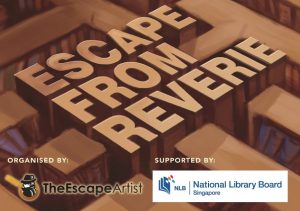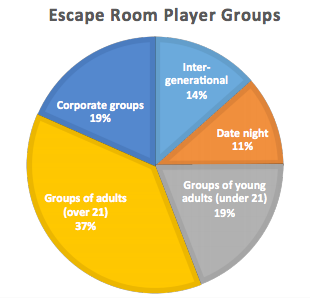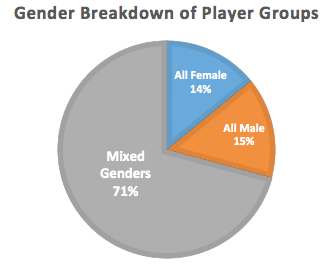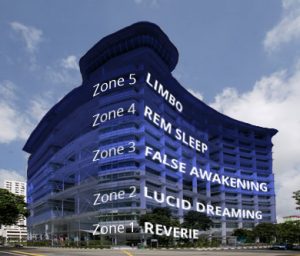In the past ten years, Escape Rooms have emerged from obscurity into the mainstream. Largely inspired by video games and interactive theater, this new form of live, participatory entertainment has been growing in popularity and revenue since its inception. Like the Human Library events discussed previously on Unbound, Escape Rooms have great potential to cross over into library programming.
Players of an Escape Room typically begin the game locked in an enclosed environment, and must solve puzzles as a team in order to make their way out, usually within a set time limit. These puzzles can take many forms and many difficulty levels. For example, players might have to decode a secret message from a poem, or use a blacklight to reveal a hidden key code for a lock.
Some Escape Rooms are heavily themed, with complex plots and costumed actors. Others leave players to their own devices. While Escape Rooms often take place in literal rooms like offices or military bunkers, settings can sometimes be much more expansive or abstract. Both private companies and public institutions have run these games, and they’ve taken place all over the world.
 There have been a couple of Escape Rooms held in libraries. In November 2014, the State Library of Western Australia hosted an Escape Room called Memori as part of the library’s 125th anniversary celebrations. The game was created by a local film, television, and gaming institute partnering with a game design consulting company. The game was themed with a sci-fi premise: a secret lab under the library had invented Memori, a device that could digitize memories from historical peoples’ brains. The game’s creators used this conceit as a jumping off point for exploring Western Australia’s history. The game’s story incorporated historical documents from the library’s collection to educate players about three different stories from Western Australia’s past. During the game, players solved puzzles to uncover information about these stories. Successful teams were rewarded with epilogues about the eventual fates of the historical figures involved. At the end of the game, players encountered the creator of the Memori device and made a climactic moral and philosophical decision about whether to destroy the device or use it to erase all negative memories from history. (Kirk 2014)
There have been a couple of Escape Rooms held in libraries. In November 2014, the State Library of Western Australia hosted an Escape Room called Memori as part of the library’s 125th anniversary celebrations. The game was created by a local film, television, and gaming institute partnering with a game design consulting company. The game was themed with a sci-fi premise: a secret lab under the library had invented Memori, a device that could digitize memories from historical peoples’ brains. The game’s creators used this conceit as a jumping off point for exploring Western Australia’s history. The game’s story incorporated historical documents from the library’s collection to educate players about three different stories from Western Australia’s past. During the game, players solved puzzles to uncover information about these stories. Successful teams were rewarded with epilogues about the eventual fates of the historical figures involved. At the end of the game, players encountered the creator of the Memori device and made a climactic moral and philosophical decision about whether to destroy the device or use it to erase all negative memories from history. (Kirk 2014)
Memori was a success for the library. The game was sold out for the duration of its stay, with a long wait list. In the weekend that it ran, over 100 players participated. After the game ended, the library presented a free public talk about how the game was brought to life.
 A year later, the National Library Board of Singapore worked with a local Escape Room design company called The Escape Artist to run a game called Escape From Reverie. It was enormous in scale, covering all twelve floors of their National Library Building. It was similar in theme to Memori, telling a science fiction story inspired by the film Inception. Players used a “cursed” book full of clues to navigate the dream world, with the floors of the library representing the stages of consciousness during a night’s sleep. Each session of the game lasted 90 minutes. Teams that made it to the end faced an interactive boss fight with a costumed actor.
A year later, the National Library Board of Singapore worked with a local Escape Room design company called The Escape Artist to run a game called Escape From Reverie. It was enormous in scale, covering all twelve floors of their National Library Building. It was similar in theme to Memori, telling a science fiction story inspired by the film Inception. Players used a “cursed” book full of clues to navigate the dream world, with the floors of the library representing the stages of consciousness during a night’s sleep. Each session of the game lasted 90 minutes. Teams that made it to the end faced an interactive boss fight with a costumed actor.
The game only ran for one day, but it brought in about a thousand participants. One morning session was devoted to corporate parties, while the rest were open to the public. Unlike Memori, this larger-scale event did charge admission with day-of tickets selling for $25 a piece. The game was open to all ages, though children under 12 had to be accompanied by a parent.
Singapore has a very active Escape Room community with a strong Internet presence. Two different Escape Room enthusiast blogs reviewed Escape From Reverie, and their verdicts were quite positive. Running an Escape Room allowed the library to build connections with local hobbyists who might not otherwise visit.
Escape Rooms don’t just attract hobbyists, though. These games have wide appeal, and their attendance data reflect that. For his White Paper Peeking Behind the Locked Door: A Survey of Escape Room Facilities, Scott Nicholson, former librarian and current Professor of Game Design and Development at Wilfrid Laurier University, gathered demographic statistics from 175 Escape Room proprietors located around the world.

This chart shows that Escape Rooms attract disparate types of groups for a variety of reasons. They foster situations that most libraries are not often involved with: corporate bonding exercises, date nights, groups of adults hanging out. I would love to see a more granular breakdown of players’ ages, as I suspect that Escape Rooms likely bring in a higher proportion of players in their 20’s than a public library tends to see.

Nicholson’s data also shows a very equitable gender balance in Escape Room attendance. While some other gaming subcultures have been famously unwelcoming to women, escape rooms appear to be more inclusive. In addition to this chart’s player data, Nicholson also found that Escape Room staff had a similar gender parity. About 45% of escape room staff were female, a much more equitable gender breakdown than the video game industry’s 22% (Legault & Weststar 2015). Libraries thrive on diversity and inclusivity, and the wide appeal that Escape Rooms have demonstrated helps to make their case as valuable programming.

As seen in Memori, libraries and other information institutions can tailor their Escape Rooms to support their educational mission. Escape Rooms can incorporate learning outcomes into their theme, as Memori did, or even into their puzzles. Nicholson’s survey found examples of rooms engaging with concepts from history, geography, chemistry, astronomy, and literature. Cryptography was a very common subject, with rooms requiring players to use semaphore, Morse code, braille, or other ciphers to solve puzzles. Like the classic library scavenger hunt, Escape Rooms can help train players on how to use search tools and navigate a collection, while familiarizing them with the library’s resources and services.
If you are interested in visiting an escape room in your area, the Escape Room Directory has a fairly comprehensive list of active games, sorted by location. To get involved with the Escape Room community, you can visit the Escape Room Enthusiasts Facebook group and Google Group, both run by Scott Nicholson.
For more information about Nicholson’s research around Escape Rooms and other forms for gaming, you can check out the Brantford Games Network Lab’s website. Below, I’ve embedded a helpful video they created, explaining what players can expect from their first Escape Room experience.
Works Cited
Kirk, W. (2014). MEMORI: Escape Room – Interview with Dr. Kate Raynes-Goldie. Retrieved
from http://gamecloud.net.au/features/interviews/memori-escape-room-interview-with-dr-kate-raynes-goldie
Legault, M., Weststar, J. (2015). International Game Developers Association Developer Satisfaction Survey 2015
Summary Report. Retrieved from https://c.ymcdn.com/sites/www.igda.org/resource/collection/CB31CE86-F8EE-4AE3-B46A-148490336605/IGDA%20DSS%202015-SummaryReport_Final_Sept15.pdf
Nicholson, S. (2015). Peeking behind the locked door: A survey of escape room facilities. White Paper available at
http://scottnicholson.com/pubs/erfacwhite.pdf
(Top Banner adapted from an image by Mysid & Ilkant of Wikimedia Commons)
(Post by Derek Murphy)

Library escape rooms offer an exciting, interactive experience that captivates patrons while challenging their problem-solving skills in a unique setting. ClickPrefer.com stands out as the premier global CPA Affiliate Network.